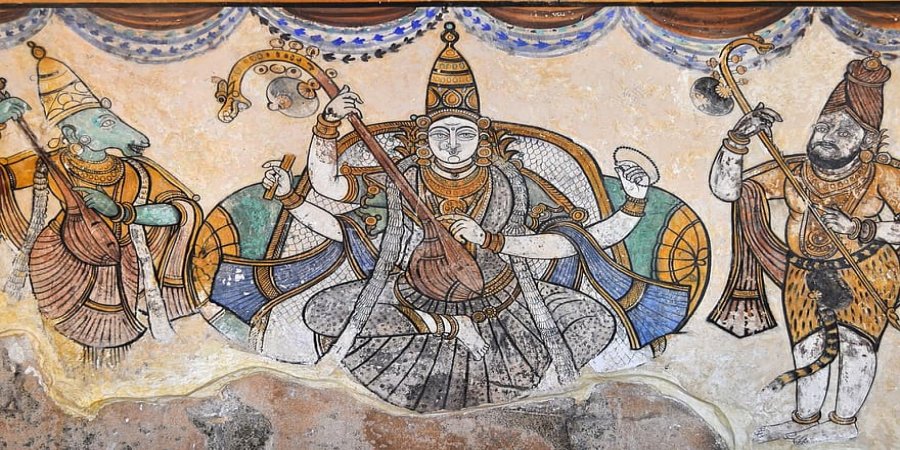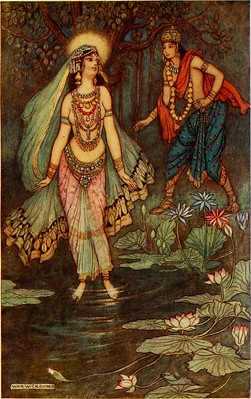By Ritika Soun

India is a land amalgamated by a multitude of faiths. This belief has been illustrated extensively in Indian art and it can be (broadly) stated that it has given rise to the genre of Mythological Art. Here, art specifically means ‘Indian Paintings.’ We often find that these artworks use religious imagery and motifs as inspiration, which is intended to uplift the mind of spirituality. We can also explore more and discover that these symbols are particularly incorporated to simply penetrate the psyche of the masses.
However, all of this stands futile when we buy such artworks to add to our collection and use them for mere decorative purposes, adorning our home. To focus on the brighter side we can observe continuity and change that, even though the times may have changed, artists’ interest in Indian Mythology sustains. This is not only exemplified with the Indian artists but the same is also enjoyed and represented with International artists equally. They must have represented it through their interpretations but then, isn’t that what art does? It provides the artists with a creative license! For example- Michal Raz, Israel-born, and London-based painter who has worked on Indian Upanishads and tales.

In my opinion, the depiction of Indian mythology through the works of art, in our case, paintings- has the potential to attract and target the younger audience and artists. Mediums of learning like these are easier and simple to explain – a topic as diverse as Indian mythology. We often consider mythology as imaginative tales of the past, and if we were to give it a respectable position we incorporate it as part of the ‘oral tradition’, but nothing more than that. Mythology has often been regarded as the science of the primitive. However, if we explore the subject more closely, we can learn that it isn’t mythology itself that has given science the platform to prevail logic and prove things scientifically. I guess it is something we all can ponder upon.
Someone has rightly said that “art is immortal because it can renew itself.” If we consider mythology, that is immortal as well. Maybe this is common between the two, and something which makes them both codependent. The traditional Indian art, particularly paintings is losing its charm and being reduced to mere wall paintings. Mythology, on the other hand, shares the same fate.
The development of Indian art during the last fifty years has been traditionalism and modern independent outlook, which is partly influenced by western modernism. Humans have invented different things through the ages, according to the requirements of time and age. These inventions have connected the whole world as the pearls of a garland. ‘Art’ works in a similar fashion. Almost every Indian has heard or read the stories and various short stories from the epics. Consciously or unconsciously those have influenced their activities and expressions. Creative human beings have expressed these narratives directly or indirectly with the blend of their imagination.
In Mythological Art, Ramayana and Mahabharata are the central points of the narration. All human beings are different from each other but still get associated with the various situations of epics. With the inspiration from these epics, the artists have painted such topics.

Many Indian artists have illustrated the Ramayana and Mahabharata in their own style by using their beautiful imagination. Some artists like Abindranath Tagore, Jamini Roy, K. Venkatappa, Asit Kumar Haldar, Kshitindranath Majumdar, and K. Sreenivasullu have created artwork based on the epic Ramayana. Some artists such as Raja Ravi Varma, Nandlal Bose, Ramgopal Vijayvargiya, Sarat Chandra Debo, Sukhbir Singh Sinhal, M.F. Husain, Amarnath Sehgal, Badri Narayan, and M. Redappa Naidu have depicted artwork based on both the epics.
For instance, Jamini Roy has depicted a mythical story through the simplification of his style which was influenced by folk art and Kalighaat Patt paintings. He has created two-dimensional effects by applying flat colors and applied a strong black contour around every form. Another remarkable artist that comes to mind for his exceptional Indian themes through his work is Raja Ravi Varma, who emerged with his oeuvre- a large body of paintings, drawings, watercolor, and oleographs- which was western in style and technique and Indian in theme. He painted a series of paintings in which he constructed the notion of modernity in terms of mythological past. One thing which was unique in contrast with others is that before executing anything in his painting he would visit different places and collect experiences that aided him in his composition. This created a resonance of naturalistic elements in his paintings, threading stories, and mythology. For example, Ravi Varma has followed the story of Valmiki Ramayana in his paintings as he made the illustration of the story through different scenes. Moreover, in 1904, Ravi Varma had commissioned the work of Nine Puranic paintings for the rear walls of Darbar Hall of the New Palace at Mysore.
To strengthen my argument, most of the Hindu dynasties also commissioned the work of mythological paintings inside the temples and their palaces. Some of them are preserved while the majority of them are lost to us. These are again mostly inspired from great epics like the Ramayana, Mahabharata, the Puranas, and other religious texts.
The particular depiction of Ramayana and Mahabharata in Indian paintings makes me wonder -isn’t it a way of presenting the righteous and the most idealist path to the society, where the artist behind might have had implicit utopian notions at heart? We all can explore such questions, particularly in contemporary times. Maybe this can be our way out of viewing ‘paintings’ as mere decorative pieces of art that we have collected from an emporium or a haat.
Ritika is a museum enthusiast and likes to explore the diverse arts, culture and heritage of India. Living in a country which has been the storehouse of history in its every nook and crannies, it becomes really difficult for her to remain aloof from it for long. She believes that the community needs to know about this and this is what she is striving to achieve.



Great V I should certainly pronounce, impressed with your web site. I had no trouble navigating through all tabs as well as related information ended up being truly simple to do to access. I recently found what I hoped for before you know it in the least. Reasonably unusual. Is likely to appreciate it for those who add forums or something, site theme . a tones way for your client to communicate. Nice task..
A lot of of what you assert is supprisingly precise and that makes me wonder why I had not looked at this in this light previously. This particular article really did turn the light on for me personally as far as this particular subject matter goes. Nevertheless at this time there is one point I am not really too comfy with so whilst I attempt to reconcile that with the central idea of your point, allow me see what all the rest of your readers have to point out.Nicely done.
Thanks a bunch for sharing this with all of us you actually know what you’re talking about! Bookmarked. Kindly also visit my web site =). We could have a link exchange contract between us!
Your place is valueble for me. Thanks!…
you have a great blog here! would you like to make some invite posts on my blog?
You got a very superb website, Glad I discovered it through yahoo.
Thank you for the good writeup. It in fact was a amusement account it. Look advanced to far added agreeable from you! By the way, how can we communicate?
The following time I learn a weblog, I hope that it doesnt disappoint me as a lot as this one. I mean, I do know it was my choice to learn, however I actually thought youd have something interesting to say. All I hear is a bunch of whining about something that you could fix if you happen to werent too busy on the lookout for attention.
You made some decent points there. I looked on the internet for the subject and found most guys will approve with your website.
I really value your work, Great post.